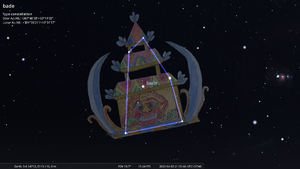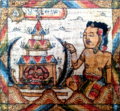Bade
Bade is an Oceanic name from Bali (Indonesia). The lintang of bade is found in intersection of Wraspati (Thursday, in saptawara) and Pon (in pancawara) in a series of palelintangan. Lintang bade means balinese corpse tower constellation.[1]
Etymology and History
The word bade is interpreted as a large and high place to carry the body that will be burned in the cemetery. Bade as a form of architecture is a type/form of traditional building in Bali that is temporary and light in the form of rocks and pepalihan, on top of which stand pavilions, specially designed for the place of the body when it will be carried from the funeral home to the cemetery.
Spelling Variants
- bade'
Origin of Constellation
In Balinese Hindu tradition, according to the Yama Purwana Tattwa lontar, every dead person (pitra) must perform a sacred offering (Yadnya). After doing atiwa-tiwa (purification), the corpse is then carried up to wadah or bade.
The maker of Bade is called undagi. Undagi creates different kinds of bade. The structure of the bade varies based on caste/social structure, level of ceremony, and the concept of imitation. This provision is judged by which family descendants can use bade with solas (11), sanga (9), pitu (7), lima (5) and so on.
Transfer and Transformation of the Constellation
Mythology / Religion
The architecture of the bade form in Bali continues to develop over time. If we trace it back, the development of the bade actually refers to the stone throne in Bali in the village of Gelgel Klungkung, which then developed into a padmasana. The stone throne is stacked and has right and left hand rests, most likely developed vertically to form a padmasana. Other forms of the stone throne are jempana, gayot or joli, container, and bade.
Another view, but not much different, is conveyed by Wiana (2004: 78-79) who stated that the development of bade originated from the simplest form, namely from pepaga, which is thought to be the oldest form of a means of carrying the bodies of Hindus in Bali. Further development became a joli, which resembles a simple bale-balean, and changed into a container or bade. The form of bade is either overlapping or without overlapping, which is called padma. The stone throne, which became the basis for the development of bade, is a medium for worshiping ancestors, such as the common belief in the megalithic era, whose influence has survived strongly until now in Bali, for example, the ngodalin ceremony in the temple and the cremation ceremony.[2]
Image Variants
Cultural Beliefs
Numerology (Neptu/Urip)
Wraspati (Thursday, in saptawara) has a value of 8 and Pon (in pancawara) has a value of 7. Thus, the total urip on this lintang is 15.[3]
Astrological Characteristics
Various dangers and diseases come in the middle age, be careful to take care of yourself and your health at the age of 50. Diseases are caused by people who are jealous of them or people who feel hurt. They are active in any business but often show off their services and skills.[3]
Matching Gemstones
Mirah (Ruby), Kalimayah (opal).[3]
Weblinks
All HIP Stars within this constellation
Stars within the Constellation Area
| id | Label | IAU design. | description | Vmag |
|---|---|---|---|---|
| 1 | Arneb | HIP 25985 | within constellation lines | 2.57 |
| 2 | Nihal | HIP 25606 | Inside the Hull | 2.84 |
| 3 | ϵ Leporis | HIP 23685 | within constellation lines | 3.18 |
| 4 | μ Leporis | HIP 24305 | within constellation lines | 3.29 |
| 5 | γ Leporis | HIP 27072 | within constellation lines | 3.6 |
| 6 | δ Leporis | HIP 27654 | within constellation lines | 3.85 |
| 7 | - | HIP 24927 | Inside the Hull | 4.729 |
| 8 | 10 Lep | HIP 25853 | Inside the Hull | 5.525 |
| 9 | - | HIP 25397 | Inside the Hull | 5.817 |
| 10 | 12 Lep | HIP 26865 | Inside the Hull | 5.89 |
| 11 | - | HIP 24786 | Inside the Hull | 5.96 |
| 12 | - | HIP 25532 | Inside the Hull | 6.065 |
| 13 | V* AK Lep | HR 1982 | Inside the Hull | 6.15 |
| 14 | - | HIP 27075 | Inside the Hull | 6.341 |
| 15 | - | HIP 24825 | Inside the Hull | 6.39 |
| 16 | - | HIP 25059 | Inside the Hull | 6.47 |
References
- References (general)
- ↑ Maass, Alfred, “Astrologische Kalender der Balinesen,” in Koninklijk Bataviaasch Genootschap van Kunsten en Wetenschappen, Feestbundel bij gelegenheid van zijn 150 jarig bestaan 1778-1928, 2 vols. (Weltevreden, 1929), Vol. 2, 126-157.
- ↑ Segara, I Nyoman Yoga, “Bade Beroda”: Transformasi dan Komodifikasi Budaya dalam Upacara Ngaben di Bali," in Mudra Jurnal Seni Budaya (2020), Vol 35(1), 94-102. DOI: 10.31091/mudra.v35i1.810
- ↑ 3.0 3.1 3.2 Tim Kajian Palelintangan, “Gabungan Kajian Palelintangan,” Museum Bali (2021), 1-149.







